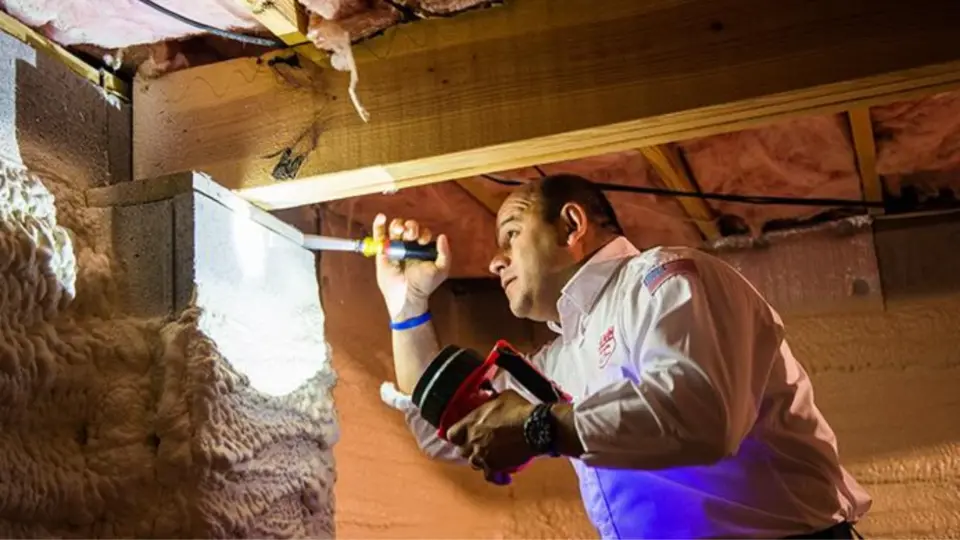
As the birds sing and flowers bloom, spring feels like a fresh start—until you realize your allergies are worse, your home smells a little… musty, and your dehumidifier can’t seem to keep up. The culprit? It might be hiding right beneath your feet.
While most people think of spring cleaning as a time to clear out closets and shake off winter dust, there’s a much less glamorous, more dangerous invader blooming in homes across the region: mold in crawlspaces.
Often out of sight and out of mind, your crawlspace could be ground zero for a full-blown mold bloom once spring rolls in. The combination of moisture, warmth, and poor airflow makes it the perfect breeding ground for mold spores that can seep into your living space—impacting not just your air quality, but your health.
Let’s dig into what’s really happening under your house this season—and why it might be time to take action before this hidden threat creeps any further.
How Does Spring Weather Contribute to Mold Growth in Crawlspaces?
Spring is that magical time when the world comes back to life. Unfortunately, so does mold.
Crawlspaces are naturally susceptible to moisture build-up, but spring conditions turbocharge the problem. Between melting snow (in colder regions), heavy rains, and rising humidity levels, moisture levels in and around crawlspaces skyrocket.
Here’s how spring weather makes things worse:
- Warm temperatures: Mold thrives in temperatures between 60°F and 80°F—spring’s sweet spot.
- Heavy rain: Seasonal showers increase groundwater pressure, pushing moisture into unsealed crawlspaces.
- Soil saturation: As the soil becomes waterlogged, excess moisture seeps into foundation walls and crawlspace floors.
- Humidity spikes: Higher outdoor humidity seeps through vents and unsealed cracks, creating condensation inside.
Once these elements combine, mold doesn’t take long to show up. Within 24–48 hours of sustained moisture exposure, mold spores can begin to grow. And once it starts, it spreads—fast.
So while you’re admiring the green returning to your garden, something green (and fuzzy) might also be sprouting under your home.
What Health Risks are Linked to Mold in Crawlspaces During Spring?
It’s easy to ignore what we can’t see. But mold in crawlspaces doesn’t stay put—it travels. Thanks to airflow patterns in most homes, air from your crawlspace eventually rises into your living space through a process known as the stack effect.
What does that mean for your health? You’re likely breathing in more than you realize.
Mold exposure can cause:
- Nasal congestion and sneezing
- Persistent coughing or throat irritation
- Watery, itchy eyes
- Worsening asthma symptoms
- Skin irritation
- Headaches or fatigue
For people with mold allergies, compromised immune systems, or chronic respiratory conditions like asthma or COPD, mold exposure can be more than just irritating—it can be dangerous.
And because crawlspace mold blooms usually go unnoticed, symptoms often persist for months before anyone makes the connection. Many homeowners spend spring and summer suffering from “seasonal allergies” without realizing the real cause is inside their home, not outside it.
Warning signs mold might be the culprit:
- Allergy-like symptoms that don’t improve with time outdoors
- A musty or earthy smell inside the home
- Increased symptoms when your HVAC system is running
- Signs of water intrusion or staining in floorboards or baseboards
If you’re experiencing these and have never checked your crawlspace, it might be time.
Why are Crawlspaces More Vulnerable to Mold Blooms in Certain Regions?
Not all crawlspaces are created equal, and not all regions face the same level of risk when it comes to spring mold blooms. Some areas are simply more vulnerable due to their climate, soil composition, or construction styles.
Crawlspaces are more at risk in regions with:
- High annual rainfall or spring flooding
- Clay-based or poor-draining soils
- Naturally humid environments
- Older homes with unsealed or vented crawlspaces
For example, in the Southeastern U.S., spring brings high humidity, heavy rain, and warm temperatures—all mold’s favorite things. Meanwhile, homes in the Pacific Northwest deal with lingering dampness long after the snow melts.
In areas with consistently wet springs, even well-built homes can fall victim to mold if their crawlspaces aren’t properly waterproofed or ventilated. And in coastal regions, salt air and excess moisture compound the problem.
Vulnerability also increases if:
- Your home was built before 1990 (many older homes have vented crawlspaces)
- The crawlspace is below grade (lower than the ground outside)
- There is no vapor barrier installed
- Water pools near your foundation after it rains
Crawlspaces are intended to protect your home from the ground up—but when they’re not sealed or maintained, they do the opposite.
Can Seasonal Humidity Levels Trigger Hidden Mold Infestations Below Homes?
Absolutely. In fact, seasonal humidity might be the single biggest trigger for hidden mold infestations in crawlspaces. And because crawlspaces are dark, enclosed, and often ignored, these infestations can grow undetected for months—until you start feeling the effects.
Spring humidity levels rise sharply as temperatures warm, and even if your crawlspace doesn’t flood, moisture can enter in more subtle ways:
- Condensation on cold surfaces, like pipes and ductwork
- High air moisture due to lack of dehumidification
- Moisture wicking through porous concrete foundations
The result? A microclimate that’s ideal for mold, especially black mold (Stachybotrys) and aspergillus, two common types found in crawlspaces. These molds thrive in damp, enclosed spaces—and once they colonize, they can compromise both structural integrity and indoor air quality.
Here’s what you can do to reduce the risk:
- Install a vapor barrier: This helps block moisture from the soil below.
- Encapsulate the crawlspace: Full encapsulation seals off outside air, preventing excess humidity.
- Add a dehumidifier: Keeping humidity below 60% is key to preventing mold.
- Improve drainage: Ensure gutters, downspouts, and grading keep water away from your foundation.
- Schedule regular inspections: Especially after heavy spring rains or flooding.
Proactive measures now can prevent months (or years) of headaches—both literally and financially.
Stop Spring Mold Blooms Before They Start
Spring is supposed to be the season of renewal—not respiratory issues and mystery odors. But if your crawlspace is damp, neglected, or unprotected, that fresh spring air might come with a hidden cost.
Mold blooms in crawlspaces don’t just affect the air beneath your home—they affect your health, your indoor environment, and your home’s longevity. As temperatures rise and moisture levels increase, it’s the perfect time to check in on what’s happening down below.
The best part? Crawlspace solutions today are more accessible, affordable, and effective than ever. You don’t have to live with a musty home, and you certainly don’t have to accept spring allergies as a given.
Don’t Let Mold Bloom Beneath Your Home—Act This Spring
Here at Freedom Crawlspace Services, we help homeowners uncover and eliminate hidden crawlspace threats before they grow into bigger problems. From moisture inspections and mold remediation to full crawlspace encapsulation, our team ensures your home stays dry, clean, and healthy all year round.
Take back your spring—starting from the ground up.
Schedule your crawlspace inspection today and say goodbye to hidden mold and hello to fresh, breathable air.
